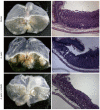8-Hydroxydeoxyguanosine: not mere biomarker for oxidative stress, but remedy for oxidative stress-implicated gastrointestinal diseases
- PMID: 22294836
- PMCID: PMC3261525
- DOI: 10.3748/wjg.v18.i4.302
8-Hydroxydeoxyguanosine: not mere biomarker for oxidative stress, but remedy for oxidative stress-implicated gastrointestinal diseases
Abstract
Reactive oxygen species (ROS) attack guanine bases in DNA easily and form 8-hydroxydeoxyguanosine (8-OHdG), which can bind to thymidine rather than cytosine, based on which, the level of 8-OHdG is generally regarded as a biomarker of mutagenesis consequent to oxidative stress. For example, higher levels of 8-OHdG are noted in Helicobacter pylori-associated chronic atrophic gastritis as well as gastric cancer. However, we have found that exogenous 8-OHdG can paradoxically reduce ROS production, attenuate the nuclear factor-κB signaling pathway, and ameliorate the expression of proinflammatory mediators such as interleukin (IL)-1, IL-6, cyclo-oxygenase-2, and inducible nitric oxide synthase in addition to expression of nicotinamide adenine dinucleotide phosphate oxidase (NOX)-1, NOX organizer-1 and NOX activator-1 in various conditions of inflammation-based gastrointestinal (GI) diseases including gastritis, inflammatory bowel disease, pancreatitis, and even colitis-associated carcinogenesis. Our recent finding that exogenous 8-OHdG was very effective in either inflammation-based or oxidative-stress-associated diseases of stress-related mucosal damage has inspired the hope that synthetic 8-OHdG can be a potential candidate for the treatment of inflammation-based GI diseases, as well as the prevention of inflammation-associated GI cancer. In this editorial review, the novel fact that exogenous 8-OHdG can be a functional molecule regulating oxidative-stress-induced gastritis through either antagonizing Rac-guanosine triphosphate binding or blocking the signals responsible for gastric inflammatory cascade is introduced.
Keywords: 8-hydroxydeoxyguanosine; Carcinogenesis; Inflammation; Oxidative stress; Prevention.
Figures



References
-
- Kim JH, Kim EH, Ock C, Hong H, Kim YJ, Kwon KA, Park DK, Hahm KB. Mitigating endoplasmic reticulum stress with revaprazan ameliorates stress-related mucosal disease. J Gastroenterol Hepatol. 2012;27:120–129. - PubMed
-
- Won I, Kim YJ, Kim SJ, Kim EH, Hahm KB. Nutrigenomic approach to tackle the unpleasant journey to Helicobacter pylori-associated gastric carcinogenesis. J Dig Dis. 2011;12:157–164. - PubMed
-
- Handa O, Naito Y, Yoshikawa T. Helicobacter pylori: a ROS-inducing bacterial species in the stomach. Inflamm Res. 2010;59:997–1003. - PubMed
-
- Farinati F, Cardin R, Cassaro M, Bortolami M, Nitti D, Tieppo C, Zaninotto G, Rugge M. Helicobacter pylori, inflammation, oxidative damage and gastric cancer: a morphological, biological and molecular pathway. Eur J Cancer Prev. 2008;17:195–200. - PubMed
-
- Trachootham D, Alexandre J, Huang P. Targeting cancer cells by ROS-mediated mechanisms: a radical therapeutic approach? Nat Rev Drug Discov. 2009;8:579–591. - PubMed
Publication types
MeSH terms
Substances
LinkOut - more resources
Full Text Sources
Other Literature Sources
Miscellaneous

